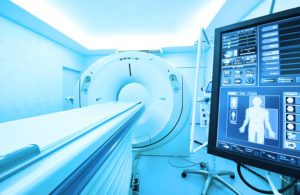
An MRI machine [Image courtesy of Times Microwave Systems]
RF interconnects, including coaxial cables and connectors, are an integral part of MRI systems.
Early awareness of challenges such as transmission loss, ease of installation and infrastructure requirements can help with performance and cost optimization in the design of new MRI systems.
Kai Loh, Times Microwave Systems
Magnetic resonance imaging (MRI) technology has advanced rapidly in the last decade. Spurred by aging populations and increased cases of certain diseases, demand for more timely and accurate diagnostics has driven both adoption of MRI and advancements. In addition to the conventional setup typically found in most healthcare facilities, mobile and portable systems development has gained momentum to broaden access and reduce wait time for MRI diagnostics.
The increased emphasis on minimally invasive surgical procedures is another driver for high-resolution medical imaging. With hardware and software enhancements, leading equipment manufacturers and research institutes have taken MRI technology to new heights. After a period of incremental development and adoption in the decades prior, the approval of 7T MRI (an ultra-high-field scanner that more than double the strength of current state-of-the-art MRI scanners) for clinical use and successful operation of an 11.7T MRI system (among the strongest MRI machines ever built) for research applications in the last five years is a giant leap forward.
Always an integral part of MRI systems, radio frequency (RF) interconnects, including coaxial cables and connectors, are keeping pace with the technology’s rapid development. It is common for system developers to allocate more resources to areas of high technical complexity. RF interconnects often take a backseat in the early stage of development projects. Missed opportunities for performance and cost optimization can stem from inadequate planning. In most cases, early awareness of challenges such as transmission loss, ease of installation, and infrastructure requirements can help avoid additional costs and future system redesign.
Transmission loss
One of the critical implications of increased magnetic field strength is the higher operating frequency from the RF interconnect perspective. The widely adopted 1.5T and 3T MRI systems operate at 63.9 MHz and 127.7 MHz, respectively. 7T systems operate at 298 MHz, and future equipment will scale even higher on the frequency spectrum. In the age of developing millimeter-wave communication, these figures may appear relatively insignificant. However, insertion loss, a key performance parameter in high power coaxial interconnects, is predominantly a square root function of frequency. Therefore, transmission at 298 MHz over the same cable length would incur about 50% more loss than 127.7 MHz. In addition to lower efficiency, cable loss is dissipated as heat and can add complexity to thermal management within the equipment or system component room.
As high operating or ambient temperature accelerates aging and other breakdown modes, robust low-loss RF interconnects with lower thermal dissipation will ultimately contribute to overall system reliability. Instead of carrying a proven design at a lower frequency over to the new systems, a holistic view of the overall interconnect requirement can lead to performance and reliability improvement opportunities. With the many recent breakthroughs in RF cable and connector products, a wide array of options support the next generation of MRI systems.
Ease of installation and cable flexibility
An MRI system installation or upgrade is a significant undertaking for any healthcare facility. A typical MRI site is a multi-room setup to ensure personnel and patient safety and meet various equipment shielding requirements. RF interconnects are an integral part of this setup, linking critical system components in different locations, often through constrained space.
Given the high-power handling requirement of MRIs, cables and connectors in the transmit path are typically larger. Additional planning to consider specific mechanical properties may improve the ease of initial installation and subsequent maintenance.
One of the critical mechanical properties for flexible coaxial cables is minimum bend radius, defined as the smallest radius a cable can be bent around without immediate damage or latent defect. The minimum bend radius for a typical flexible cable is 6 to 10 times the overall cable diameter. However, cables with specific construction and material combinations, including the stranded center conductor, foil shield, and optimized dielectric density, can offer a much-reduced bend radius while balancing the power handling need. Understanding minimum bend radius aids the cabling plan for an MRI site and prevents damage from a cable making an excessively tight turn. A more flexible cable can improve handling and directly impact ergonomics, resulting in shorter installation time and other tangible benefits.
Cable flexibility in a dynamic environment such as the patient table poses a different challenge. Repeated flexure can lead to material fatigue and displacement, with a damaged center conductor or shield being the typical failure mode. Cables with a stranded center conductor, especially those with high strand count, are optimal solutions in a high flexure environment. Although the stranded configuration is inherently higher loss, the improvement in flex life and overall connection reliability in most cases outweighs the marginal increase in insertion loss.
Infrastructure requirements
As MRI systems often need to fit into infrastructure with pre-existing constraints and limitations, the layout of RF and other interconnects is seldom straightforward. Depending on the installed location, plenum or riser-rated cables are required to meet building code and general fire safety requirements. To attain the CMP (plenum) or CMR (riser) rating, the coaxial cable must pass rigorous tests and demonstrate its capability to resist flame and minimize smoke, requiring the use of specialty insulator materials. With the many variations in building code and product flame resistance rating, it can be challenging to identify a cable that meets the right electrical and mechanical requirements. Fortunately, most high-performance cables are now available in flame-resistant versions with CMP or CMR rating, making optimal interconnect solutions for MRI at the system and infrastructure level a reality.
Although RF interconnects design is typically less complex when compared to active components in an MRI system, the optimal solution requires an end-to-end approach and accounts for key technical aspects. Whether upgrading existing systems or pushing the envelope of next-generation technology, a general understanding of cable and connector properties, operating conditions, and infrastructural constraints can help overall performance.

Kai Loh [Photo courtesy of Times Microwave Systems]
Kai Loh has worked in the RF/microwave industry for two decades and held various roles in engineering, marketing, and product management. His product experience ranges from microelectronic components to interconnects for technically demanding applications.
The opinions expressed in this blog post are the author’s only and do not necessarily reflect those of MedicalDesignandOutsourcing.com or its employees.